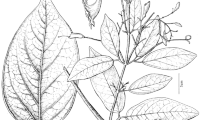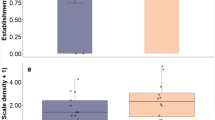Abstract
Phenology and female cone characteristics of the two endemic cedars (Juniperus cedrus and J. brevifolia) from the Macaronesian islands were studied. Despite their closely taxonomic affinity and their evolution under insular conditions, different trends were recorded. Mature J. cedrus female cones were present throughout the year, while those from J. brevifolia were only present in summer and autumn. J. cedrus female cone size was significantly larger than that of J. brevifolia, a trend consistent with the presence of larger vertebrates (lizards and birds) in the Canary Islands. However, water content was four times higher in J. brevifolia female cones, which can be related with the higher rainfall existing in the Azores. J. cedrus has two or three seeds per cone, whereas J. brevifolia frequently had three. Seeds from J. cedrus were clearly larger and heavier, coinciding with the female cone size trend. However, tetrazolium tests revealed higher viability values in J. brevifolia. The relatively low percentage of filled seeds in J. cedrus could be a consequence of the climatic stress and limits to pollination due to fragmented populations as described for other Juniperus species. In summary, our results reveal that some environmental factors such as the harsh conditions, high population fragmentation and the dependence on large dispersers have compromised the fitness of J. cedrus in the Canary Islands.


Similar content being viewed by others
References
Adams RP (2000) Systematics of Juniperus section Juniperus based on leaf essential oils and random amplified polymorphic DNA’s (RAPDs). Biochem Syst Ecol 28:515–528
Adams RP (2008) Junipers of the world: the genus Juniperus. Trafford Publishing, Vancouver
Adams RP, Demeke T, Abulfatih HA (1993) RAPD DNA fingerprints and terpenoids: clues to past migrations of Juniperus in Arabia and east Africa. Theor Appl Genet 87:22–26
Arista M, Ortiz PL, Talavera S (1997) Reproductive isolation of two sympatric subspecies of Juniperus phoenicea (Cupressaceae) in southern Spain. Plant Syst Evol 208:225–237
Baskin CC, Baskin JM (1998) Ecology, biogeography, and evolution of dormancy and germination. Academic Press, London
Blanca G, Cabezudo B, Hernández-Bermejo JE, Herrera CM, Molero J, Muñoz J, Valdés B (eds) (1999) Libro rojo de la flora silvestre amenazada de Andalucía. Tomo I: especies en peligro de extinción. Consejería de Medio Ambiente, Sevilla
Borges PAV, Brown VK (1999) Effects of island geological age on the arthropod species richness of Azorean pastures. Biol J Linn Soc 66:373–410
Bustos JJ, Delgado FS (2004) Clima. In: Canseco (ed) Parque Nacional del Teide. Talavera de la Reina, pp 73–96
Cantos M, Cueva J, Zárate R, Troncoso A (1998) Embryo rescue and development of Juniperus oxycedrus subsp. oxycedrus and macrocarpa. Seed Sci Tech 26:193–198
Carracedo JC, Day S (2002) Canary Islands. Terra Publishing, Hertfordshire
Chambers JC, Vander Wall SB, Schupp EW (1999) Seed and seedling ecology of piñon and juniper species in the pygmy woodland of western North America. Bot Rev 65:1–38
Debussche M, Cortez J, Rimbault I (1987) Variation in fleshy fruit composition in the Mediterranean region: the importance of ripening season, life-form, fruit type and geographical distribution. Oikos 49:244–252
Dias E, Elias RB, Nunes V (2004) Vegetation mapping and nature conservation: a case study in Terceira Island (Azores). Biodivers Conserv 13:1519–1539
Donald RK, Cooke TJ (1997) Fundamental concepts in the embryogenesis of dicotyledons: a morphological interpretation of embryo mutants. Plant Cell 9:1903–1919
Elias RB (2007) Ecologia das florestas de Juniperus dos Açores. Ph.D. dissertation. Azores University, Angra do Heroísmo
Elias RB, Dias E (2004) Primary succession on lava domes on Terceira (Azores). J Veg Sci 15:331–338
Elias RB, Dias E (2009) Gap dynamics and regeneration strategies in Juniperus–Laurus forest of the Azores Islands. Plant Ecol 200:179–189
França Z, Cruz JV, Nunes JC, Forjaz VH (2003) Geologia dos Açores: uma perspectiva actual. Açoreana 10:11–140
García D, Gómez JM, Zamora R, Hódar JA (2000a) a Do empty Juniperus communis seeds defend filled seeds against predation by Apodemus sylvaticus? Écoscience 7:214–221
García D, Zamora R, Gómez JM, Jordano P, Hódar JA (2000b) Geographical variation in seed production, predation and abortion in Juniperus communis throughout its range in Europe. J Ecol 88:436–446
Hernández E, Nogales M, Martín A (2000) Discovery of a new lizard in the Canary Islands, with a multivariate analysis of Gallotia (Reptilia: Lacertidae). Herpetologica 56:63–76
Herrera CM (1992) Interspecific variation in fruit shape: allometry, phylogeny, and adaptation to dispersal agents. Ecology 73:1832–1841
Herrera CM (2002) Seed dispersal by vertebrates. In: Herrera CM, Pellmyr O (eds) Plant-animal interactions. An evolutionary approach. Blackwell Science, Oxford, pp 185–208
Howe HF, Westley LC (1990) Ecological relationships of plants and animals. Oxford University Press, New York
IUCN (2008) The IUCN Red List of threatened species. Available via http://www.iucnredlist.org. Accessed 25 Nov 2008
Izquierdo I, Martín JL, Zurita N, Arechavaleta M (eds) (2004) Lista de especies silvestres de Canarias (hongos, plantas y animales terrestres) 2004. Consejería de Medio Ambiente y Ordenación Territorial, Gobierno de Canarias, Santa Cruz de Tenerife
Jordán de Urríes F (1997) Aproximación a la viabilidad de las semillas de J. cedrus Webb & Berthelot de Canarias. Aplicación y comparación con J. oxycedrus ssp badia Debaux del centro peninsular. In: Puertas F, Rivas M (eds) I Congreso Forestal Hispano Luso. II Congreso Forestal Español. Pamplona, España, pp 331–336
Jordano P (1995) Angiosperm fleshy fruits and seed dispersers: a comparative analysis of adaptations and constraints in plant-animal interactions. Am Nat 145:163–191
Juan R, Pastor J, Fernández I, Diosdado JC (2003) Relationships between mature cone traits and seed viability in Juniperus oxycedrus L. subsp. macrocarpa (Sm.) Ball (Cupressaceae). Acta Biol Cracov Bot 45:69–78
Juan R, Pastor J, Fernández I, Diosdado JC (2006) Seedling emergence in the endangered Juniperus oxycedrus subsp. macrocarpa (Sm.) Ball in southwest Spain. Acta Biol Cracov Bot 48:49–58
Marzol MV, Yanes A, Romero C, Brito de Azevedo E, Prada S, Martins A (2006) Los riesgos de las lluvias torrenciales en las islas de la Macaronesia (Azores, Madeira, Canarias y Cabo Verde). In: Cuadrat JM, Saz MA, Vicente SM, Lanjeri S, de Luis Arrillaga M., González-Hidalgo JC (eds) Clima, Sociedad y Medio Ambiente. Publicaciones de la Asociación Española de Climatología (AEC), Serie A, no 5, pp 443–452
Nogales M, Hernández EC, Valdés F (1999) Seed dispersal by common ravens Corvus corax among island habitats (Canarian Archipelago). Écoscience 6:56–61
Noma N, Yumoto T (1997) Fruiting phenology of animal-dispersed plants in response to winter migration of frugivores in a warm temperate forest on Yakushima Island, Japan. Ecol Res 12:119–129
Ortiz PL, Arista M, Talavera S (1998) Low reproductive success in two subspecies of Juniperus oxycedrus L. Int. J Plant Sci 159:843–847
Petersen JL, Ueckert DN, Taylor CA, Shaffer KR (2005) Germination of Redberry Juniper (Juniperus pinchotii) seed in western Texas. Texas J Agric Nat Res 18:28–30
Scharpf RF (1970) Seed viability, germination and radicle growth of dwarf mistletoe in California. USDA For Serv Res Paper PSW 59:1–3
Sjögren E (2001) Plants and flowers of the Azores. Os Montanheiros, Angra do Heroísmo
Tanaka Y (1984) Assuring seed quality for seedling production: cone collection and seed processing, testing, storage, and stratification. In: Duryea ML, Landis TD (eds) Forest, nursery manual: production of bareroot seedlings. Martinus Nijhoff/Dr W. Junk Publishers, Boston, pp 27–39
Thomas PA, El-Barghathi M, Polwart A (2007) Biological flora of the British islets: Juniperus communis L. J Ecol 95:1404–1440
Thompson JN, Willson MF (1979) Evolution of temperate fruit/bird interactions: phenological strategies. Evolution 33:973–982
Valido A (1999) Ecología de la dispersión de semillas por los lagartos endémicos canarios (g. Gallotia, Lacertidae). Ph.D. thesis. Universidad de La Laguna, La Laguna, Spain
Wesche K, Ronnenberg K, Hensen I (2005) Lack of sexual reproduction within mountain steppe populations of the clonal shrub Juniperus sabina L. in semi-arid southern Mongolia. J Arid Environ 63:390–405
West MAL, Harada JJ (1993) Embryogenesis in higher plants: an overwiew. Plant Cell 5:1361–1369
Wildpret de la Torre W, Martín Osorio VE (2004) Flora vascular y vegetación. In: Canseco (ed) Parque Nacional del Teide. Talavera de la Reina, pp 97–142
Acknowledgments
The staff of El Teide National Park (Organismo Autónomo de Parques Nacionales), particularly Ángel Bañares, Manuel Durbán and Manuel Marrero, facilitated our work in this protected area. José Mª Fernández-Palacios and Robert P. Adams revised an early version of this contribution. Pedro Jordano provided us with important comments and suggestions, and he also helped us with some analyses using the JMP statistical package. We thank Raquel Gutiérrez for technical support. B.R. and A.R. were financed by two grants conceded by the Spanish National Research Council (CSIC). D.P.P. was funded by a PhD grant awarded by the Canary Islands Government. This work was partially financed by a Canary Islands Government project (PI2007/053), partially supported by FEDER funds from the European Union.
Author information
Authors and Affiliations
Corresponding author
Additional information
Communicated by R. Matyssek.
Rights and permissions
About this article
Cite this article
Rumeu, B., Nogales, M., Elias, R.B. et al. Contrasting phenology and female cone characteristics of the two Macaronesian island endemic cedars (Juniperus cedrus and J. brevifolia). Eur J Forest Res 128, 567–574 (2009). https://doi.org/10.1007/s10342-009-0304-4
Received:
Revised:
Accepted:
Published:
Issue Date:
DOI: https://doi.org/10.1007/s10342-009-0304-4




